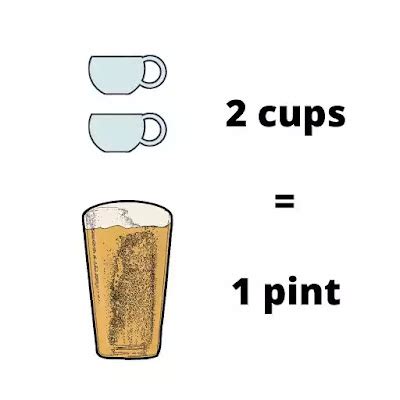How Many Pints Are In 1 Pound
listenit
Mar 31, 2025 · 4 min read

Table of Contents
How Many Pints Are in 1 Pound? Understanding Liquid and Weight Measurements
The question, "How many pints are in 1 pound?" is deceptively simple. It highlights a crucial distinction often missed: we're dealing with two different measurement systems – weight (pounds) and volume (pints). There's no direct conversion factor because a pound measures mass, while a pint measures volume. The number of pints in a pound depends entirely on the density of the liquid.
The Density Conundrum: Why There's No Single Answer
A pound of feathers and a pound of lead weigh the same, but they occupy vastly different volumes. Similarly, a pound of water will take up a different volume than a pound of oil or a pound of mercury. This is because each substance possesses a unique density.
Density is defined as mass per unit volume. Commonly expressed as grams per cubic centimeter (g/cm³) or kilograms per liter (kg/L), it dictates how much mass is packed into a given space. The higher the density, the more mass in a given volume.
Therefore, to answer "how many pints are in 1 pound," we need to specify the liquid's density. This is why you won't find a simple conversion like you would with, say, converting ounces to pints.
Calculating Pints from Pounds: A Step-by-Step Guide
Let's break down how to calculate the volume (in pints) of a pound of a particular liquid. We'll need:
-
The density of the liquid: This information is readily available online for most common liquids. We'll express this in pounds per pint (lb/pt) for ease of calculation.
-
The weight of the liquid: In this case, we know it's 1 pound.
Here's the formula:
Volume (in pints) = Weight (in pounds) / Density (in pounds per pint)
Let's illustrate this with a few examples:
Example 1: Water
The density of water is approximately 1.04 pounds per pint (slightly more than 1 pound per pint because of variations in temperature and pressure).
Using the formula:
Volume (in pints) = 1 pound / 1.04 pounds/pint ≈ 0.96 pints
Therefore, 1 pound of water is approximately 0.96 pints.
Example 2: Milk
The density of milk varies depending on the fat content, but a reasonable approximation is 1.03 pounds per pint.
Using the formula:
Volume (in pints) = 1 pound / 1.03 pounds/pint ≈ 0.97 pints
Therefore, 1 pound of milk is approximately 0.97 pints.
Example 3: Oil
The density of vegetable oil is approximately 0.92 pounds per pint.
Using the formula:
Volume (in pints) = 1 pound / 0.92 pounds/pint ≈ 1.09 pints
Therefore, 1 pound of vegetable oil is approximately 1.09 pints.
Understanding the Implications of Density Variations
As you can see, the volume of a pound of liquid can vary significantly depending on its density. This difference is crucial in many applications:
-
Food and Beverage Industry: Accurate density measurements are vital for controlling ingredient ratios and ensuring consistent product quality in manufacturing processes.
-
Chemical Engineering: Density is a fundamental property affecting fluid flow, heat transfer, and reaction kinetics in chemical processes.
-
Pharmaceutical Industry: Precise density measurements are essential for accurate drug dosage and formulation.
-
Environmental Science: Density plays a role in understanding water quality, pollution dispersion, and sediment transport.
Beyond Pints and Pounds: Exploring Other Units
While pints and pounds are common units in some regions, the concept of density remains universal. Similar calculations can be performed using different units:
-
Liters and Kilograms: The density of water is approximately 1 kilogram per liter (1 kg/L), making calculations straightforward in the metric system. A kilogram of water would occupy approximately 1 liter.
-
Gallons and Pounds: Converting pounds to gallons requires the density of the liquid expressed in pounds per gallon.
-
Cubic Feet and Pounds: Similar conversions can be made using the density expressed in pounds per cubic foot.
Practical Applications and Common Misconceptions
The relationship between weight and volume is not always intuitive. Many misconceptions arise from failing to consider density:
-
Assuming a fixed conversion factor: There is no universal conversion factor between pounds and pints. The conversion depends entirely on the substance's density.
-
Confusing weight and volume: Weight measures mass, while volume measures space occupied. These are distinct concepts.
-
Ignoring temperature effects: Density can vary with temperature. Accurate calculations require knowing the temperature of the liquid.
Conclusion: Mastering the Interplay of Weight and Volume
Understanding the relationship between pounds and pints requires grasping the concept of density. There's no single answer to how many pints are in a pound because the volume depends on the liquid's density. By applying the formula provided and consulting density data, you can accurately calculate the volume of a given weight of liquid. This knowledge is crucial in various fields, highlighting the importance of distinguishing between mass and volume measurements. Remember to always consider the specific liquid's density and potentially its temperature for accurate results. This understanding is vital for precision in countless applications, from everyday cooking to complex industrial processes.
Latest Posts
Latest Posts
-
Unit Of Measurement For Kinetic Energy
Apr 02, 2025
-
How Do Lichens Contribute To Primary Succession
Apr 02, 2025
-
Number Of Valence Electrons In Calcium
Apr 02, 2025
-
How Many Valence Electrons In Calcium
Apr 02, 2025
-
Write A Quadratic Equation With The Given Roots
Apr 02, 2025
Related Post
Thank you for visiting our website which covers about How Many Pints Are In 1 Pound . We hope the information provided has been useful to you. Feel free to contact us if you have any questions or need further assistance. See you next time and don't miss to bookmark.
